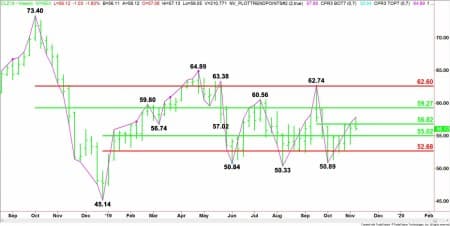After posting an impressive rally on Monday through Wednesday, U.S. West Texas Intermediate crude oil futures are trading lower on Friday, putting the market in a position to finish lower for the week.
The primary catalyst behind the price action this week was U.S.-China trade relations. Optimism over the progress of the negotiations drove prices higher early in the week, but uncertainty over the timing of the signing of a trade deal encouraged long investors to book profits and trim positions late in the week.
Concerns over Trade Deal
On Thursday, China and the U.S. announced they would roll back tariffs. This temporarily raised the chances of a near-term deal, sending crude oil prices higher. However, that move didn’t last.
Furthermore, the decision to roll back tariffs is causing some problems with Trump administration hardliners who fear the U.S. may lose its leverage against China if it continues to make concessions.
WTI and Brent crude oil sold-off sharply on Wednesday after a report that a meeting between U.S. President Donald Trump and Chinese President Xi Jinping to sign an interim deal could be delayed until December as talks continue over terms and venue, a senior official of the Trump administration told Reuters on Wednesday.
It was still possible the “phase one” agreement aimed at ending a damaging trade war would not be reached, but a deal was more likely than not, the official said on condition of anonymity.
Rising Supply…
After posting an impressive rally on Monday through Wednesday, U.S. West Texas Intermediate crude oil futures are trading lower on Friday, putting the market in a position to finish lower for the week.
The primary catalyst behind the price action this week was U.S.-China trade relations. Optimism over the progress of the negotiations drove prices higher early in the week, but uncertainty over the timing of the signing of a trade deal encouraged long investors to book profits and trim positions late in the week.
Concerns over Trade Deal
On Thursday, China and the U.S. announced they would roll back tariffs. This temporarily raised the chances of a near-term deal, sending crude oil prices higher. However, that move didn’t last.
Furthermore, the decision to roll back tariffs is causing some problems with Trump administration hardliners who fear the U.S. may lose its leverage against China if it continues to make concessions.
WTI and Brent crude oil sold-off sharply on Wednesday after a report that a meeting between U.S. President Donald Trump and Chinese President Xi Jinping to sign an interim deal could be delayed until December as talks continue over terms and venue, a senior official of the Trump administration told Reuters on Wednesday.
It was still possible the “phase one” agreement aimed at ending a damaging trade war would not be reached, but a deal was more likely than not, the official said on condition of anonymity.
Rising Supply Issues
Crude oil was also pressured by the news that U.S. stockpiles rose 7.9 million barrels the week ending November 1 as refiners cut output and exports fell, the Energy Information Administration (EIA) said on Wednesday. Traders were looking for an increase of 1.5 million barrels.
Helping to ease the pressure on prices was the news that gasoline and distillate inventories dropped 2.8 million barrels and by 622,000 barrels respectively.
Stocks at the Cushing, Oklahoma, the delivery hub for WTI, rose by 1.7 million barrels, the EIA said.
Doubts over Potential OPEC Production Cuts
Weeks ago, OPEC and its allies suggested that deeper production cuts could be coming in an effort to offset the impact of falling demand. However, this week’s remarks from an OPEC official are casting doubts on whether the cartel and its friends will have to cut output.
OPEC Secretary-General Mohammad Barkindo said this week that he was more optimistic about the outlook for 2020 because of potentially positive developments on trade disputes, appearing to downplay any need to cut output more deeply.
Given that OPEC’s decision to trim production has been underpinning prices for nearly three years, a decision to make even deeper cuts at the start of 2020, would have been a bullish development. Traders betting on this outcome had been providing support for weeks, but Barkindo’s comments suggest the buying may have been premature. Longs are trimming those bets ahead of OPEC’s major meeting on December 5 -6, when they will decide to cut output or stand pat.
Weekly Technical Analysis
Weekly December WTI Crude Oil Technical Analysis

Weekly Swing Chart Technical Analysis
The main trend is up according to the daily swing chart, however, momentum has been trending lower since the main top was reached the week-ending September 20. A trade through $50.89 will change the main trend to down. The main trend will change to up on a trade through $62.74.
The main range is $73.40 to $45.14. Its 50% to 61.8% retracement zone at $59.27 to $62.60 is the primary upside target and potential resistance zone.
The short-term range is $45.14 to $64.89. Its 50% to 61.8% retracement zone at $55.02 to $52.68 is potential support.
The minor range is $62.74 to $50.89. Its 50% level or pivot at $56.82 was tested this week. Trader reaction to this level will tell us if the buying is strong enough to trigger a further rally toward the main retracement zone and main top. Or, retest the support area and try to form a support base.
Weekly Swing Chart Technical Forecast
Based on this week’s price action, the direction of the December WTI crude oil market this week is likely to be determined by trader reaction to the pivot at $56.82.
Bullish Scenario
A sustained move over $56.82 will indicate the presence of buyers. If this move can create enough upside momentum then look for the rally to possibly extend into the main 50% level at $59.27.
Bearish Scenario
A sustained move under $56.82 will signal the presence of sellers. The first downside target is the short-term 50% level at $55.02. If this price fails as support then we could see a further break with the short-term Fibonacci level at $52.68 the next likely target.
Conclusion
Given the current supply/demand fundamentals, we’re likely to continue to see further attempts to establish a support between $55.02 and $52.68 as traders await the announcement of “phase one” of a partial trade deal between the United States and China. Prices could rally when the two economic powerhouses finally decide on a signing venue.
Gains could be limited, however, because a short-term trade deal may not be enough to offset worries about future demand growth.


















